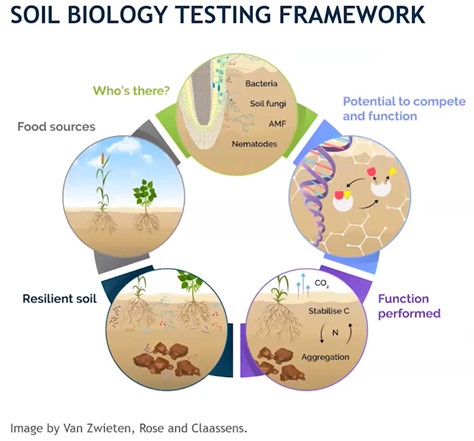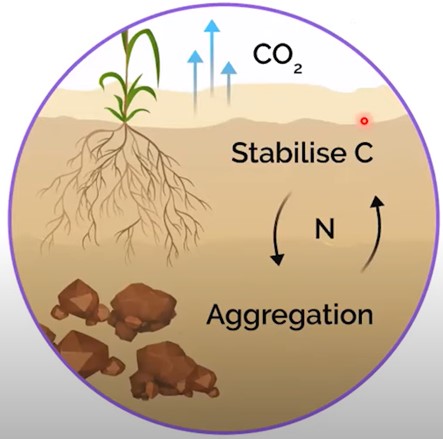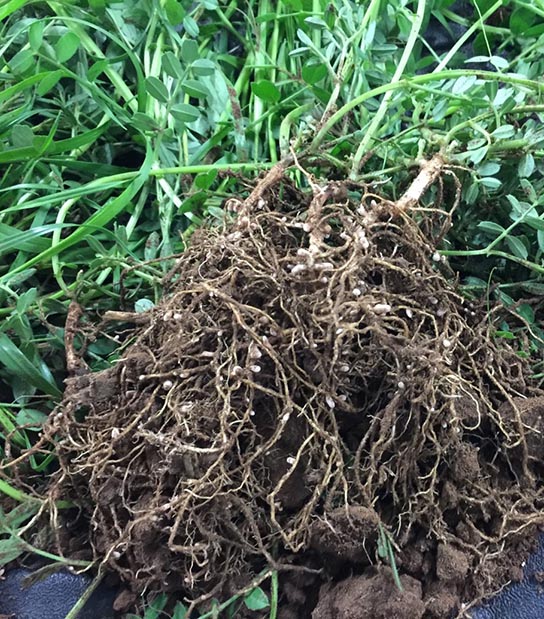There is recognition amongst farmers and scientists alike that soil biology is an important component in healthy soil. But selecting what to measure is confounding and analysing what the data really mean can be even more so.
This fact sheet supports the presentation by Soil CRC Program Leader Dr Lukas Van Zwieten (NSW Department of Primary Industries), that highlighted some of the key methods for measuring ‘who’s there’ and ‘what they’re doing.’ The methodologies are being applied to Soil CRC field trials to help us understand changes to soil biological properties and how these may more broadly benefit soil health.
Significance of soil biology in agriculture
Understanding soil biology is crucial for enhancing soil resilience, improving crop growth, and ensuring overall farm and environmental sustainability. Soil biology influences soil health, and by knowing its impact, strategies may be implemented to promote diverse microbial communities, leading to improved soils and crops.
The Soil CRC conducts field trials, including initiatives like cover cropping and intercropping, to maximise microbial diversity and foster positive changes in soil biology, contributing to sustainable farming practices.
Assessing soil biology: the importance of the microbial food source
The foundation of understanding soil biology lies in evaluating the microbial food source, derived from root exudates, leaf litter, and soil organic matter. Techniques like total organic carbon analysis and examination of carbon fractions provide insights into the bioavailability of carbon. Additionally, assessing the quality of root exudates plays an important role in influencing the rhizosphere microbial community.
This comprehensive framework aims to unravel the complexities of soil biology, emphasising the significance of the initial microbial food source in fostering a resilient and sustainable soil ecosystem.

Assessing soil microorganisms: techniques and insights
Various techniques, including analysing microbial food sources and employing DNA methods like quantitative polymerase chain reaction (qPCR), provide valuable insights into soil biology. Understanding the microbial biomass carbon, metabolic quotient, and mycorrhizal symbiosis aids in gauging soil health, responding to land management, and making agronomic decisions. This multifaceted approach, encompassing molecular and morphological assessments, offers a comprehensive understanding of soil microorganisms’ abundance, functionality, and their symbiotic relationships with plants, contributing to sustainable crop production.
Advanced techniques for soil microbial analysis
Utilising high-end methods like DNA sequencing and co-occurrence networks provides deeper insights into soil microbial communities. Factors like organic amendments and iron amendments impact microbial diversity, influencing soil properties such as carbon storage and aggregation. These advanced techniques contribute to a comprehensive understanding of microbial ecology, enabling informed decisions for sustainable soil management.
Functional insights through enzyme activity and testing
Assessing soil enzyme activity and microbial community function through techniques like Biolog testing provides valuable insights into carbon, nitrogen, phosphorus, and sulphur cycling. Enzyme functions, such as chitinase, are indicative of improved soil health, while Biolog testing reveals microbial responses to factors like herbicide exposure, enhancing our understanding of soil microbial dynamics and their impact on ecosystem processes.
Functional assessment beyond potential: From PMN to cellulose breakdown
Functional evaluation of soil goes beyond potential mineralizable nitrogen (PMN) by integrating mid-infrared spectroscopy, enabling quicker and more actionable insights for fertiliser decisions. Additionally, the development of a cellulase test using the same spectroscopy provides a novel approach to assess biological breakdown of cellulose in soil, crucial for understanding carbon dynamics. These advancements offer a more dynamic perspective on soil function, enhancing precision in agronomic decisions.
Soil health metrics: resistance, resilience, and the interplay of biology, physics, and chemistry
Metrics like resistance and resilience offer insights into soil’s ability to maintain functions under stress and recover post-stress. Ongoing research integrates stable isotopes, enzyme assessments, and mid-infrared spectroscopy, providing a comprehensive view. The challenge lies in aligning the trio of biology, physical properties, and chemistry for optimal soil health, acknowledging the complex interplay that influences resilience and resistance in agricultural systems.
Enhancing carbon sequestration: challenges and opportunities in agricultural practices
Accurate science is pivotal in promoting the correct message about carbon sequestration in soils. The focus is on collecting diverse data related to farm practices, interventions, and various soil types, aiming to improve evidence-based understanding of carbon sequestration opportunities. This approach involves a comprehensive analysis of data from different farming systems, soil types, and climatic conditions, contributing to a more nuanced understanding of soil carbon dynamics and the potential for long-term sequestration.


Related Soil CRC projects
- Project 2.1.008 Measuring soil microbes
- Project 2.3.002 Visualising Australasia’s Soils: extending the soil data federation
- Project 3.4.001 Evaluating alternative rhizobial carriers
- Project 3.4.002 Evaluation of innovative microbial carrier products
- Project 4.1.003 Evaluating soil functional resilience
- Project 4.1.007 Building soil resilience and carbon through plant diversity
Further information
- Soil Quality: 5 Soil Biology (SoilsWest) – available on Apple Books
- Case study: Selecting and testing biological amendments (South West NRM)
- Victorian Resources Online (Agriculture Victoria)
- Herbicide effects on soil biology (NSW Department of Primary Industries)
- SoilsWest (Western Australia)
- Soil Science Australia soil resources
- SOILHEALTH app (University of Western Australia)
Acknowledgement
This fact sheet was published as part of the ‘Building technical capacity for improved soil management’ project. It was produced by the Soil CRC and jointly funded through the Australian Government’s National Landcare Program.
Posted Apr 18, 2024

